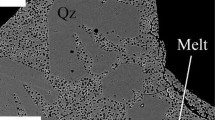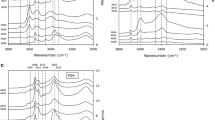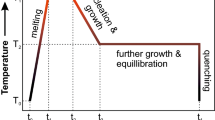Abstract
OH incorporation in quartz in Al-, B- and Li-bearing systems (granitic systems containing tourmaline or spodumene) was studied experimentally in order to investigate the effect of pressure, temperature and chemical impurities on the generation of OH-defects. High-pressure experiments were carried out at pressures between 5 and 25 kbar and temperatures between 800 and 900 °C, and OH-contents in quartz were calculated from IR absorption spectra measured on oriented quartz crystals. IR absorption features were assigned to impurity substitutions, such as AlOH (3,420, 3,379 and 3,315 cm−1) and BOH (3,595 cm−1), LiOH (3,483 cm−1), and hydrogarnet substitution (4H)Si defects (3,583 cm−1). Results indicate a negative correlation of incorporated Al-specific OH-defect content versus pressure (630 ± 130 wt ppm H2O at 5 kbar to 102 ± 6 wt ppm H2O at 25 kbar), but no clear correlation of B-specific OH-defects with pressure. In runs initially containing spodumene, virtually OH-free quartzes were observed at pressures ≥10 kbar, where impurity cations compensate each other forming an anhydrous eucryptite-defect component. In contrast, at 5 kbar, both Li- ad Al-specific OH-defects are observed (corresponding to 470 ± 75 wt ppm H2O). Results from this study may therefore be used to monitor formation conditions of quartz in terms of pressure and trace metal saturation of the crystallizing petrological system. IR spectra obtained from natural quartz grains from a tourmaline-bearing pegmatite exhibit B- and Al-related OH-bands. The B-related OH-band is also exhibited in quartz from a tourmaline + spodumene-bearing pegmatite. Li- and Al-related OH-bands, however, are subordinate or not observed at all in the spodumene-bearing system, which suggests that OH-vibrations do not reflect absolute Li-contents in quartz due to efficient coupled substitution involving Al. Data from experimental runs and natural specimens indicate that the B-related OH-band can be used as a rough proxy for B-contents in quartz, confirming the previously postulated charge balance equation [H+] = [B3+] + [Al3+] − [Li+] − [K+] − [P5+].










Similar content being viewed by others
References
Aines RD, Rossman GR (1984) Water in minerals? A peak in the infrared. J Geophys Res 89:4059–4071
Aines RD, Kirby SH, Rossman GR (1984) Hydrogen speciation in synthetic quartz. Phys Chem Miner 11:204–212
Bambauer HU (1961) Spurenelementgehalte und γ-Farbzentren in Quarzen aus Zerrklüften der Schweizer Alpen. Schweiz Min Petr Mitt 41:335–369
Bambauer HU (1963) Merkmale des OH-Spektrums alpiner Quarze (3µ-Gebiet). Schweiz Min Petr Mitt 43:259–268
Chakraborty D, Lehmann G (1976) Distribution of OH in synthetic and natural quartz crystals. J Solid State Chem 17:305–311
Göd R (1989) The spodumene deposit at “Weinebene”, Koralpe, Austria. Miner Depos 24:270–278
Griggs DT, Blacic JD (1965) Quartz: anomalous weakness of synthetic crystals. Science 147:292–295
Huang WL, Wyllie PJ (1973) Melting relations of muscovite-granite to 35 kbar as a model for fusion of metamorphosed subducted oceanic sediments. Contrib Miner Pet 42:1–14
Jacamon F, Larsen RB (2009) Trace element evolution of quartz in the charnockitic Kleivan granite, SW-Norway: the Ge/Ti ratio of quartz as an index of igneous differentiation. Lithos 107:281–291
Jochum KP, Weis U, Stoll B, Kuzmin D, Yang Q, Raczek I, Jacob DE, Stracke A, Birbaum K, Frick DA, Günther D, Enzweiler J (2011) Determination of reference values for NIST SRM 610–617 glasses following ISO guidelines. Geostand Geoanal Res 35:397–429
Kats A (1962) Hydrogen in alpha quartz. Philips Res Rep 17:133–279
Li J, Xia S, Gao S (1995) FT-IR and Raman spectroscopic study of hydrated borates. Spectrochim Acta 51A:519–532
Libowitzky E, Rossman GR (1997) An IR calibration for water in minerals. Am Miner 82:1111–1115
London D (1984) Experimental phase equilibria in the system LiAlSiO4–SiO2–H2O: a petrogenetic grid for lithium-rich pegmatites. Am Miner 69:995–1004
Melcher F, Göd R, Konzett J, Mali H (2010) Niobium–tantalum–tin bearing minerals in pegmatites of the Eastern Alps: case studies. Pangeo 2010 abstracts. J Alp Geol 52:178
Miyoshi N, Yamaguchi Y, Kuniaki M (2005) Successive zoning of Al and H in hydrothermal vein quartz. Am Miner 90:310–315
Müller A, Koch-Müller M (2009) Hydrogen speciation and trace element contents of igneous, hydrothermal and metamorphic quartz from Norway. Miner Mag 73:569–583
Paterson MS (1986) The thermodynamics of water in quartz. Phys Chem Miner 13:245–255
Rossman GR (2006) Analytical methods for measuring water in nominally anhydrous minerals. In: Keppler H, Smyth JR (eds) Water in nominally anhydrous minerals. Rev Mineral Geochem 62:1–28
Rovetta MR (1989) Experimental and spectroscopic constraints on the solubility of hydroxyl in quartz. Phys Earth Planet Int 55:326–334
Stalder R, Konzett J (2012) OH-defects in quartz in the system quartz–albite–water and granite–water between 5 and 25 kbar. Phys Chem Miner 39:817–827
Stalder R, Neuser RD (2013) OH-defects in detrital quartz grains: potential for application as tool for provenance analysis and overview over crustal average. Sed Geol 294:118–126
Thomas SM, Koch-Müller M, Reichart P, Rhede D, Thomas R, Wirth R (2009) IR calibrations for water determination in olivine, r-GeO2 and SiO2 polymorphs. Phys Chem Miner 36:489–509
Acknowledgments
Hannes Witting is thanked for manufacturing the high-pressure assemblies. Ulf Hålenius and Thomas Götte are thanked for constructive reviews.
Author information
Authors and Affiliations
Corresponding author
Rights and permissions
About this article
Cite this article
Baron, M.A., Stalder, R., Konzett, J. et al. OH-point defects in quartz in B- and Li-bearing systems and their application to pegmatites. Phys Chem Minerals 42, 53–62 (2015). https://doi.org/10.1007/s00269-014-0699-4
Received:
Accepted:
Published:
Issue Date:
DOI: https://doi.org/10.1007/s00269-014-0699-4




